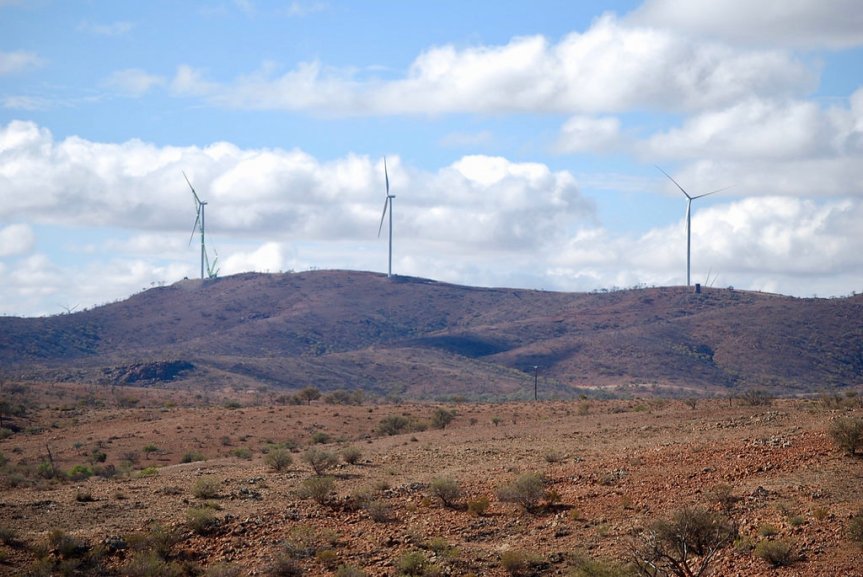RE rent seekers aren’t satisfied with $trillions in wind and solar subsidies, now they want $trillions for power grids to the middle of nowhere.
The Australian wind industry has a habit of spearing its turbines way beyond the back of beyond. Increasingly remote wind farm locations require serious upgrades to transmission infrastructure, adding hundreds of $millions to transmission costs, that would have otherwise been avoided, had Australia simply stuck with conventional generators and not squandered $60,000,000,000 in subsidies to intermittent wind and solar.
As any first-year physics student will tell you, transmitting electricity over distances results in a mathematically predictable loss of the power transmitted, over any given distance. The greater the distance, the greater the absolute loss.
Just like the value of prime real estate, the most beneficial situation for generating capacity is all about location, location, location.
In the main, conventional generators are sited close enough to the majority of the load (i.e. power consumers) – such that the transmission losses involved amount to relative trickles.
A few weeks back, the grid manager determined to hit remote wind and solar operators with penalties for their substantial transmission losses over distance. Predictably, wind and solar operators howled ‘blue murder’.
The story is much the same in the USA, where RE rent seekers are demanding that taxpayers fork out (yet again) to build a transmission grid to take power at chaotic, random intervals from wind and solar plants scattered across the American heartland.
AWEA Misinformation
Power for USA
Donn Dears
12 April 2019
A representative of the American Wind Energy Association wrote what amounted to an op-ed in Power Magazine, claiming that building more transmission lines would make the grid more efficient.
While there was a grain of truth in the proposal, it masked the truth.
The core of her argument was that more transmission lines would bring wind from distant parts of the country to where it could be used.
She said:
“Now is the time to expand the nation’s network of transmission lines to bring electricity from the country’s most renewable-rich sites to the cities.”
What this would mean, in real terms, is to spend billions of dollars unnecessarily on new transmission lines.
While new transmission lines can improve efficiencies in certain areas where existing lines need to be expanded or interconnected with other transmission lines, building new lines to transport electricity thousands of miles is merely expensive.
Here is the basic question:
Is it better to build a natural gas power plant close to where it’s needed or build a wind farm a thousand miles from where the electricity can be used, and in each case build a new transmission line to carry the electricity from either the new wind farm or a new NGCC power plant?
In each instance, the plant would generate 6 billion kWh per year of electricity.
The cost of building an 800 MW natural gas combined cycle (NGCC) power plant would be $800 million (800,000 KW * $1,000 per KW) and have a capacity factor of 85%.
The cost of building a comparable wind farm would be $3,800 Million (1,900,000 KW * $2,000 per KW). The larger capacity is needed because the capacity factor of the wind farm would only be 36%. However, the costs are calculated so that the total generation of 6 billion kWh is the same for both the wind farm and NGCC power plant.
The distance between Billings, Montana, near where excellent wind conditions are found, to Chicago is 1,245 mils. Or alternatively from Casper, Wyoming, is 1,092 miles.
The cost of constructing a new 230 KV transmission line is approximately $1 million per mile.
The table compares the cost of the two alternatives: A new wind farm where renewable wind is plentiful, with an NGCC power plant near where the electricity can be used.
| Wind Farm | NGCC | |
| Cost of plant | $3,800,000,000 | $800,000,000 |
| Cost of Transmission Line | $1,100,000,000 | $100,000,000 |
| Total | $4,900,000,000 | $900,000,000 |
These costs ignore some other factors. Line losses, for example, will be about 11 times worse for the wind farm than for the NGCC alternative.
In addition, wind is unreliable and may not be available when it’s needed. And the winters where the wind farm is built are severe. See, Wind Power Warning
Obviously, the AWEA proposal is vey expensive and amounts to spending $4 trillion unnecessarily.
No matter how rosy a picture the American Wind Energy Association paints, wind is always less reliable and more expensive.
Power for USA



It would be reasonable for the proponents of the wind power to provide an additional equivalent gas plant.
How equivalence is calculated can be negotiated, somewhere between the peak MW capacity of the wind as described, or the much lower gas.
Taking the lower prices, it is equivalent to:
Gas = $900M
Wind = $4900M + $900M = $5900M.
Otherwise, expect no electricity when the wind isn’t blowing 1000miles away from home.
Reblogged this on ajmarciniak.